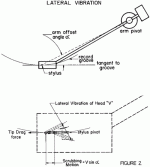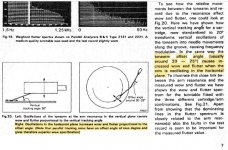Probably he uses some Higgs field reducer in the base. Or the platter is actually a hollow styrofoam cylinder. Or the record he plays is not made of vinyl but dark matter. No real name, no actual location, he may as well lives in a parallel universe connecting to the internet through an interdimensional quantum tunneling leak. We actually know nothing for certain....post #93 shows some turntable with a monsterous platter...
...Even I, for one, know a machine like that wouldn't have any problem playing a damn record...
Us grumpy old zeroes are supposed to simply shut up, nod repeatedly, be overwhelmed, drool and stand to the side. 🙂
Have mercy. He may spray his coffee through his nose if asked....anyone with some idea of such things could explain and answer with some intelligence.
I think we had some tests over in the Test LP thread.
We did and found nothing using the best analysis we could muster. If anyone comes up with another experiment to try sure we could set it up.
On the speed stability thread we also had some data from an exceedingly well setup Lenco L75 to show that they can work as well as anything else but nothing can beat a well tuned technics SP-10. At what point it drops below an audibility threshold was not explored.
The conclusion was that one should pick one's preference and learn how to tune it up regularly.
That looks like a Verdier turntable. They are monstrous in good way, I've been able to use them from time to time and even met Mr Verdier. It's a magnetic levitation platter and quite massive. On a very high end system they are stunningly good, simply transparent. And you are correct, with all that mass they have no trouble plowing thru changes in groove dynamics. It's just physics, after all.Schmitz77's post #93 shows some turntable with a monsterous platter.

Thanks Bill. I thought we did, but there was a lot going on in that thread. It would be nice to see this tested again in a different way.We did and found nothing using the best analysis we could muster. If anyone comes up with another experiment to try sure we could set it up.
I did start looking at if there were test records where you could play 2 tracks with different arms and look for a wobble due to drag, but lost interest as I cannot afford the divorce required to get a TT with two arms 😀
You keep pouring this nonsense.If you've heard every argument, while not making your own practical experiences and tell others instead of presenting another theory?
Easy to test (have done). Simple setup. Frequency counter. Turntable. Ortofon SPU of a kind. Stylus pressure 4 grammes (tough enough load???)
Ortofon testrecord, 315Hz lateral, 50-60-70-80-90-100uM modulation.
(the latter four sound awful on the SPU) 😀
Result: DIY stringdrive-70mm height acryllic platter/Acoustic solid wood black-belt drive/Micro Seiki DQL-120-400mm diameter platter..............
No deviation whatsoever....... It´s all in your head 😛
As for listening...... The Thorens TD-124 does NOT have any better bass punch than my Acoustic Solid Wood (my personal experience).
Last edited:
You are right Schmitz, I just started in audio last month. And (true confession) I have never actually heard, built or tested anything - I just read about it on the interwebs. You found me out!! 😱
Plus, what do you mean about a time before the Internet? That's just crazy talk, there has always been an Internet.
Good one Pano 😀😀😀
Schmitz77's post #93 shows some turntable with a monsterous platter.
It's one of those "esoteric" and silly machines that I mentioned earlier with what looks like a string drive.
Now can anybody with some knowledge and experience actually tell me that once spinning at 33rpm, that platter is going to slow down, even momentarily, with the "drag" of a tiny stylus tip in a modulated groove?
Physics, inertia, the "flywheel effect", and mass are at play here, of course, and anyone with some idea of such things could explain and answer with some intelligence.
Even I, for one, know a machine like that wouldn't have any problem playing a damn record.
Even though I'd never have something like that thing in the house - I'm more reasonable than that.
No reason to explain anything. One of my friends has one (La Platine Verdier), and it´s by
far the most steady TT, he´s ever owned. His plinth is black, and it´s actually kind of pretty (meaning his wife likes it too) 🙂
Last edited:
One of my turntables, a Kenwood, considered "junk" by the stuffy brainwashed audiofool crowd, performs excellently.
It's platter is only about 2 pounds, driven by a relatively weak Direct Drive servo system.
Tapping on it results in a dull thud, no ringing, the platter has a molded-on permanent outer skin. (rubber/neoprene?)
That platter spindle rides on a single ball bearing, encased in (by me) Super Lube grease.
When turned on, it gets to 33.3RPM in less than one revolution, and does so absolutely silently.
As a matter of fact, when spun to high RPM's (300+) by hand, and an ear an inch from the spindle, absolutely nothing is heard - no "whirring", no "clunkling", nothing....silence.
Then, a linear arm sets the stylus down - also silently - no need for anti-skate stuff.
In playing the record, there is no rumble, other than the actual "background" floor-level stuff from the vinyl itself, which of course depends on the quality of the record.
There is no tiny "speed changes" resulting from a heavy modulation in the groove/music.
None....nothing.
I've confirmed this with a test record having the classic test tones and varying modulations with an oscilloscope connected.
I've got none of that "sloppy bass" junk going on, and physics suggest that a bass groove modulation would be of less friction a high-frequency one, like a trumpet.
It's only in your mind to think otherwise.
So why does the hype continue about "high end" stuff, other than people insisting on it being better because of cost and superficial design?
How come "budget" stuff like my Kenwood rarely if ever gets positive attention?
It's platter is only about 2 pounds, driven by a relatively weak Direct Drive servo system.
Tapping on it results in a dull thud, no ringing, the platter has a molded-on permanent outer skin. (rubber/neoprene?)
That platter spindle rides on a single ball bearing, encased in (by me) Super Lube grease.
When turned on, it gets to 33.3RPM in less than one revolution, and does so absolutely silently.
As a matter of fact, when spun to high RPM's (300+) by hand, and an ear an inch from the spindle, absolutely nothing is heard - no "whirring", no "clunkling", nothing....silence.
Then, a linear arm sets the stylus down - also silently - no need for anti-skate stuff.
In playing the record, there is no rumble, other than the actual "background" floor-level stuff from the vinyl itself, which of course depends on the quality of the record.
There is no tiny "speed changes" resulting from a heavy modulation in the groove/music.
None....nothing.
I've confirmed this with a test record having the classic test tones and varying modulations with an oscilloscope connected.
I've got none of that "sloppy bass" junk going on, and physics suggest that a bass groove modulation would be of less friction a high-frequency one, like a trumpet.
It's only in your mind to think otherwise.
So why does the hype continue about "high end" stuff, other than people insisting on it being better because of cost and superficial design?
How come "budget" stuff like my Kenwood rarely if ever gets positive attention?
Your ear is not a phono cartridge so not sure what you are proving there.As a matter of fact, when spun to high RPM's (300+) by hand, and an ear an inch from the spindle, absolutely nothing is heard - no "whirring", no "clunkling", nothing....silence.
A scope is the wrong tool for the job. You need to measure modulation of the test tone. Luckily a 30 line python script does this for you, unless you have a cupboard full of B&K gear.I've confirmed this with a test record having the classic test tones and varying modulations with an oscilloscope connected.
I've got none of that "sloppy bass" junk going on,
One of my turntables, a Kenwood
Which Kenwood model is this exactly?
Those Kennwoods were actually built by Micro Seiki, correct?
Best regards,
Ulf
Please forgive me as a "newbie" on here but most High end TT's seem to employ a radial tonearm system. The introduction of a linear tracking TT many years ago would suggest that the master of the record being played was produced on a lathe with the cutter moving in a linear fashion. If this is the case, then a TT with a radial arm can only be correctly aligned with the record groove at one spot on the surface of the disc and out of alignment before and after this point. Perhaps I am going over old ground discussed before but can someone explain please."Then, a linear arm sets the stylus down"
Keep safe,
Mike
It´s actually two points on the surface.
On a protractor (to adjust your cartridge setup) you usually have two points, where the cartridge should align. To make the variations around the Zero point as small as possible.
Better with +-1 instead of 0 to +2 🙂
But otherwise you´re right. Over the whole surface you have variations from the optimal tracking angle with a radial arm 🙂
On a protractor (to adjust your cartridge setup) you usually have two points, where the cartridge should align. To make the variations around the Zero point as small as possible.
Better with +-1 instead of 0 to +2 🙂
But otherwise you´re right. Over the whole surface you have variations from the optimal tracking angle with a radial arm 🙂
Linear tracking arms in theory have huge advantages over radial trackers, but the implementations can leave things lacking. There are a number of DIY linear arm projects on here. Some heroic in their implementations.
It’s the scrubbing, not the alignment…
The real advantage of linear tracker arms in terms of the topic of this thread is that the zero offset angle of the LT results in less FM/flutter when the arm experiences horizontal resonances. LT arms produce less ‘scrubbing’ of the stylus. Less scrubbing produces less FM/flutter, which shows up as a pitch instability of the turntable.
Offset arm (radial):
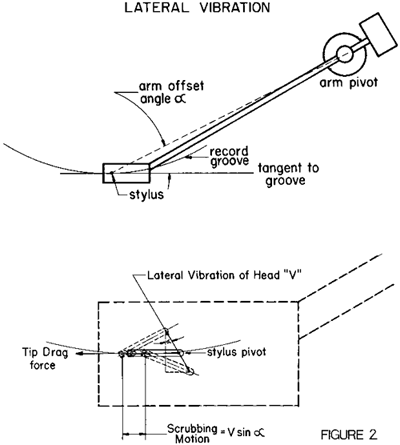
Zero Offset Arm (Linear Tracker):
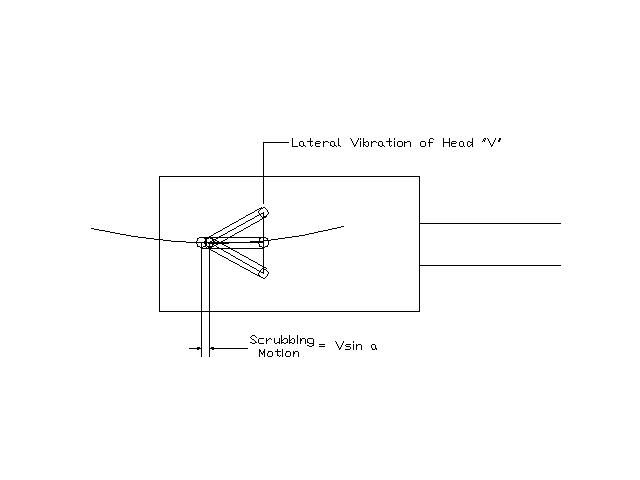
B&K did a study in which they mounted 3 arms on the same turntable and measured wow & flutter for each case. They found that each of the 3 arm/cartridge combinations yielded different W&F values, with the LT arm being the lowest – all on the same turntable (see pages 6-9).
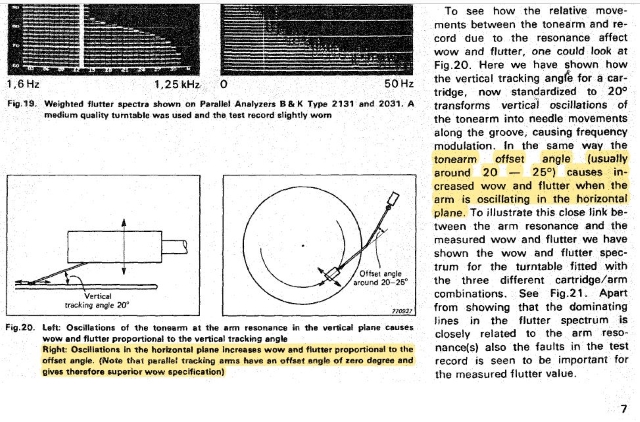
This was discussed in the pitch stability thread. I started a separate thread on the topic here:
Don't listen to records on FM!
but I think I only managed to put everyone to sleep with the gory details. Misalignment doesn’t affect the measured W&F but offset angle does.
Ray K
The real advantage of linear tracker arms in terms of the topic of this thread is that the zero offset angle of the LT results in less FM/flutter when the arm experiences horizontal resonances. LT arms produce less ‘scrubbing’ of the stylus. Less scrubbing produces less FM/flutter, which shows up as a pitch instability of the turntable.
Offset arm (radial):
Zero Offset Arm (Linear Tracker):
B&K did a study in which they mounted 3 arms on the same turntable and measured wow & flutter for each case. They found that each of the 3 arm/cartridge combinations yielded different W&F values, with the LT arm being the lowest – all on the same turntable (see pages 6-9).
This was discussed in the pitch stability thread. I started a separate thread on the topic here:
Don't listen to records on FM!
but I think I only managed to put everyone to sleep with the gory details. Misalignment doesn’t affect the measured W&F but offset angle does.
Ray K
Attachments
I always say this
It’s analog audio, enjoy it with all its imperfections as well as it’s perfection. Way too many people overthink the concept of audio reproduction and get caught up in the rabbit hole and snake oil . To find the ever elusive ( perfect sound )
I’ve got myself into this hole many times
Spending way to much time trying to ( have the perfect setup ) this is impossible to do.
Now I find myself enjoying my systems for hours, instead of fiddling with the system for hours on end and only getting minutes of enjoyment from the sound that the system could reproduce.
So many times people spend tons of money to find the Golden Sound. And then you could only tell the difference with some type of measurement gear such as an oscilloscope or specialty built measurement device. remember the ear is the ultimate measurement device that you have. Trust your ears.
It’s analog audio, enjoy it with all its imperfections as well as it’s perfection. Way too many people overthink the concept of audio reproduction and get caught up in the rabbit hole and snake oil . To find the ever elusive ( perfect sound )
I’ve got myself into this hole many times
Spending way to much time trying to ( have the perfect setup ) this is impossible to do.
Now I find myself enjoying my systems for hours, instead of fiddling with the system for hours on end and only getting minutes of enjoyment from the sound that the system could reproduce.
So many times people spend tons of money to find the Golden Sound. And then you could only tell the difference with some type of measurement gear such as an oscilloscope or specialty built measurement device. remember the ear is the ultimate measurement device that you have. Trust your ears.
Although this may be true, clearly is, the main attraction to LT is the obvious, the difference which can easily be heard. The issues you bring up are dependent on varying circumstances but the zero tracking error is constant.The real advantage of linear tracker arms in terms of the topic of this thread is that the zero offset angle of the LT results in less FM/flutter when the arm experiences horizontal resonances. LT arms produce less ‘scrubbing’ of the stylus. Less scrubbing produces less FM/flutter, which shows up as a pitch instability of the turntable.
Offset arm (radial):
Zero Offset Arm (Linear Tracker):
B&K did a study in which they mounted 3 arms on the same turntable and measured wow & flutter for each case. They found that each of the 3 arm/cartridge combinations yielded different W&F values, with the LT arm being the lowest – all on the same turntable (see pages 6-9).
This was discussed in the pitch stability thread. I started a separate thread on the topic here:
Don't listen to records on FM!
but I think I only managed to put everyone to sleep with the gory details. Misalignment doesn’t affect the measured W&F but offset angle does.
Ray K
I have general sentiment as most posters here. Of course there are many variables to consider. I use a Kenwood kd-500, Technics sl-ql1, and Acoustic signature Neo all carts with Shibata stylus. After transferring my entire LP collection to digital, I can say I prefer the speed stability and low tracking error of the Technics.(it's more consistent to playing long running lp's) Even though many linear tracking tables from the 80's are suspect, there are may good ones like the Technics with aluminum bodies or artificial hematite. Actually I don't know how the Japanese could design something this complicated and sell it for the asking price. Thats great engineering for ya'. Now manufacture's are jumping on the band wagon with direct drives and linear arms and asking $30K.
- Home
- Source & Line
- Analogue Source
- Can one turntable sound better than another?
